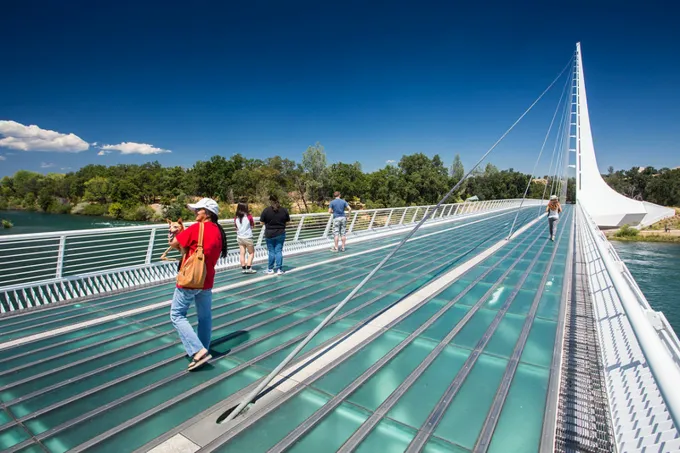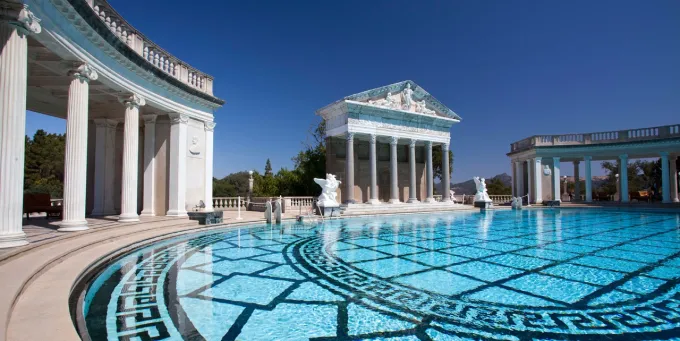Even if you don’t know the difference between a bungalow and a Bauhaus box, you’ll still get a kick out of seeing some of California’s most unforgettable architecture. For those already bitten by the design bug, the Architecture Gems road trip is a must, but anyone can have a blast by simply touring Greater Palm Springs’ famous Mid-century Modern treasures, or strolling through neighborhoods such as Sacramento’s Fabulous Forties or Mendocino’s Historic Preservation District for an impressive dose of standout structures. Cross an iconic span (Instagramming the whole way, of course), tour the State Capitol, and visit a museum housed in a building that is a work of art itself, and you’ll be tossing off phrases like “double-domed rotunda” and “cantilevered” in no time.
Read on to learn about 9 of California’s architectural treasures, listed from north to south.
1. Sundial Bridge, Redding
A functional work of art, this remarkable bridge, designed by renowned Spanish architect Santiago Calatrava, spans the tree-lined, trout-filled Sacramento River in Redding’s Turtle Bay Exploration Park. The 700-foot span is undeniably striking, with its glass block walkway and soaring white tower and suspension cables forming a functioning sundial—a nod to human creativity and ingenuity, both important themes of the 300-acre park. (More: Sundial Bridge)
2. State Capitol, Sacramento
With its noble columns and snappy cupola, all painted wedding-cake white, California’s State Capitol building in Sacramento looks like a mini replica of the U.S. Capitol in Washington, D.C. Take a free tour to learn about the 1869 building’s architecture and history. Outside, stroll through the adjacent 40-acre Capitol Park, where you can admire trees from around the world, and visit the Civil War Memorial Grove—in 1897, saplings from famous Civil War battlefields were planted here. (More: State Capitol)
3. Golden Gate Bridge, San Francisco
With towers soaring 746 feet into the sky, its span arcing across the mouth of San Francisco Bay, and all of it painted bright red-orange, San Francisco’s Golden Gate Bridge is, quite simply, amazing. It’s pretty easy (and free) to walk across the bridge itself, or to explore the Golden Gate Bridge Welcome Center, which offers a colorful look at the bridge’s history, as well as the original 12-foot stainless-steel “test tower” used in 1933. (More: Golden Gate Bridge)
4. Bixby Bridge, Big Sur
Welcome to Bixby Bridge, Big Sur’s version of the Golden Gate—a must-see road trip spot for many and probably the most Instagrammed feature along the Highway 1 coastline. And rightly so. Pull over at numerous turnouts to get amazing views, particularly from the bridge’s south end at sunset. But whether you are snapping away or not, be sure to take advantage of the multiple viewpoints; they are key for reveling in 360-degree views instead of just the direction you are going. (More: Bixby Bridge)
5. Hearst Castle, San Simeon
Mansions are abundant in California, but nothing comes close to Hearst Castle. As the private residence of publishing magnate William Randolph Hearst, the complex, completed in 1947, is an extraordinary temple to opulence and excess. Now showcased within one of California’s most visited state parks, it is a must-see, an eye-popping extravaganza with a 165-room castle, 127 acres of terraced gardens, fountains and pools, plus, to top it all off, wraparound views of the sunny Central Coast. (More: Hearst Castle)
6. The Getty Center, Los Angeles
The main branch of the Getty Center, one of the Los Angeles’ many world-class museums, looks like an elevated modernist city. Whether you go for the art, for free weekend music and theater performances, for kid-friendly workshops, or just to find the perfect place for a relaxing picnic lunch, the Getty Center has something for everyone. Even better? Outside of paying for parking, admission is free. (More: The Getty Center)
7. Walt Disney Concert Hall, Los Angeles
With its soaring stainless-steel panels, the exterior of Los Angeles’ Frank Gehry-designed Walt Disney Concert Hall has been likened to everything from a clipper ship to a blooming flower to origami. Outside, take a self-guided or guided tour, including a stop at the third-level garden for city views and the rose-shaped Lillian Disney Fountain, made from crushed Delft porcelain and a meant as a tribute to the woman who made the concert hall possible. (More: Walt Disney Concert Hall)
8. Sunnylands Center and Gardens, Greater Palm Springs
Elrod House, Twin Palms, the Kauffman House… these are a few of Greater Palm Springs’ exceptional examples of Mid-century modern architecture. Add to those this 200-acre former estate of publishing magnate and UK ambassador Walter Annenberg and his wife Lenore. Dubbed Sunnylands, it lets you peek into a lifestyle of the uber-rich and connected, circa 1966. The couples’ glass-walled 25,000-square-foot Rancho Mirage home is a masterpiece that showcases a notable art collection, and the garden is home to many local and migratory bird species. Visitors can stroll through its 1.25 miles of garden for no charge. (More: Sunnylands Center and Gardens)
9. Catalina Casino, Catalina Island
From its regal setting at the north end of Catalina Island’s Avalon Harbor, the dramatic circular building that houses the Catalina Casino has stood as a welcoming sentinel since just before the Great Depression. As it did back then, the impressive Art Deco building hosts lavish dances and performances, and first-run movies are screened in the elaborately painted theater on the lower level. Guided walking tours are also a must, shedding light on Avalon’s history and Hollywood connection. (More: Catalina Casino)



